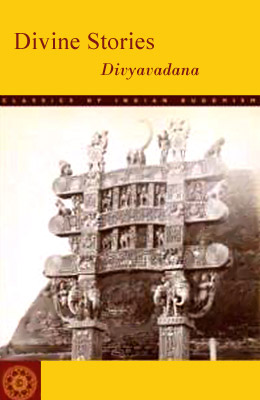 Divyavadana or `Heavenly deeds` is an anthology of thirty eight Buddhist tales that is composed in the Sanskrit Language. It is an enormous compendium of Indian Buddhist narratives whose stories have since spread throughout Asia. These stories have spread as narrative and narrative art leaving a permanent mark on Buddhist thought. Many of tales originated in Mulasarvastivada vinaya texts. The stories are ancient. They are the first Buddhist texts that have been committed to writing. The stories depict Buddha explaining to a group of disciples how a particular individual through actions in previous life have a particular karmic result.
Divyavadana or `Heavenly deeds` is an anthology of thirty eight Buddhist tales that is composed in the Sanskrit Language. It is an enormous compendium of Indian Buddhist narratives whose stories have since spread throughout Asia. These stories have spread as narrative and narrative art leaving a permanent mark on Buddhist thought. Many of tales originated in Mulasarvastivada vinaya texts. The stories are ancient. They are the first Buddhist texts that have been committed to writing. The stories depict Buddha explaining to a group of disciples how a particular individual through actions in previous life have a particular karmic result.
Punya is a dominating theme that has been accrued from making offerings to enlightened beings and other holy sites related to Lord Buddha. Divyavadana contains 38 stories in all, including the well-known Asokavadana. The collection contains the story of Buddha where he creates the famous depiction of wheel of life, which depicts the twelve links of dependent origination and the cycle of samsara for King Rudrayana.
The stories of Divyavadana are:
* Kotikarna-avadana
* Purna-avadana
* Maitreya-avadana
* Brahmnaadarika-avadana
* Stutibrahmana-avadana
* Indrabrahmana-avadana
* Nagaravalambika-avadana
* Supriya-avadana
* Mendhakagrhapativibhuti-pariccheda
* Mendhaka-avadana
* Asokavarna-avadana
* Pratiharya-sutra
* Svagata-avadana
* Sukarika-avadana
* Cakravartivyakrta-avadana
* Sukapotaka-avadana
* Mandhata-avadana
* Dharmaruci-avadana
* Jyotiska-avadana
* Kanakavarna-avadana
* Sahasodgata-avadana
* Candraprabhabodhisattvacarya-avadana
* Sangharaksita-avadana
* Nagakumara-avadana
* Sangharaksita-avadana
* Pamsupradana-avadana
* Kunala-avadana
* Vitasoka-avadana
* Asoka-avadana
* Sudhanakumara-avadana
* Toyikamaha-avadana
* Rupavati-avadana
* Sardulakarna-avadana
* Danadhikarana-mahayanasutra
* Cudapaksa-avadana
* Makandika-avadana
* Rudrayna-avadana
* Maitrakanyaka-avadana
The story of Rudrayna avadana depicts King Rudrayana. He offered a gift of a jewelled robe to King Bimbisara of Magadha. King Bimbisara was worried as he did not have anything equivalent value to offer as a gift. Bimbisara went to Lord Buddha for advice. Buddha advised to have the first drawing of the Bhavachakra made and told Bimbisara to send the drawing to Rudrayana. It is said that Rudrayana attained realization through studying this drawing. These stories had a canonical influence on Buddhist art. These stories have been represented in Sanchi stupas. This anthology is considered as one of the most influential stories in history of Buddhism. The stories highlight the moral economy of karma, depicting how faithful offerings can bring the reward of future happiness and thereby attaining liberation. These tales also speak about Dhamma or Dharma in an interesting manner.




















